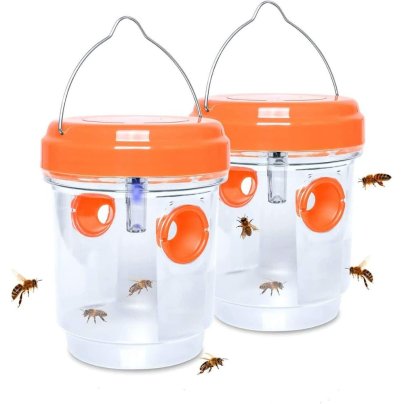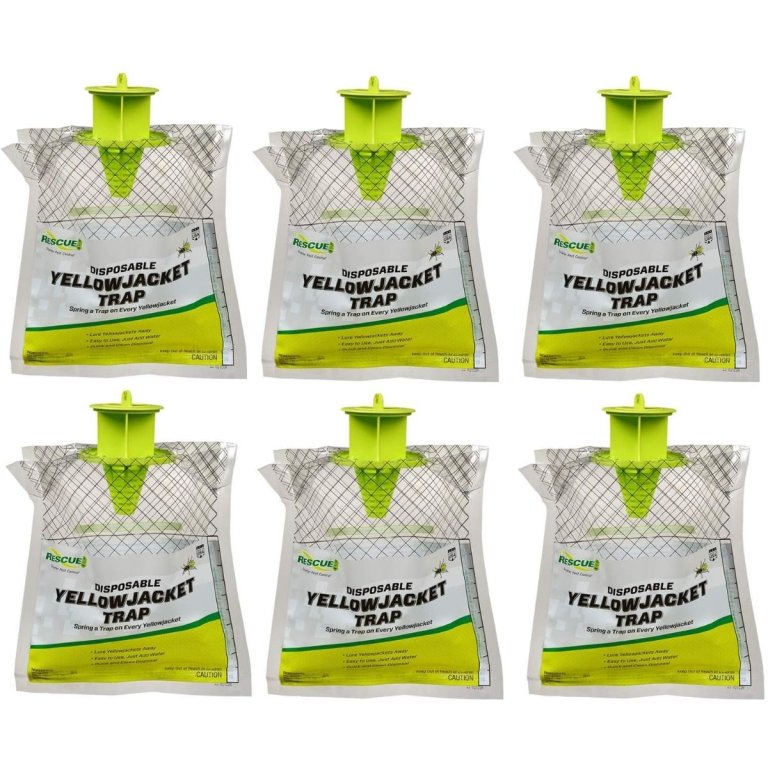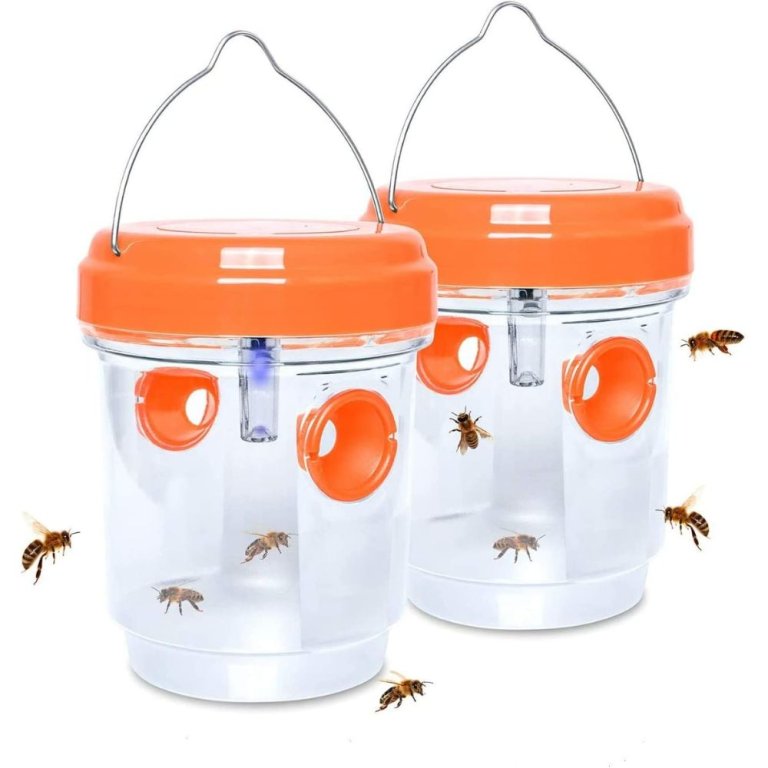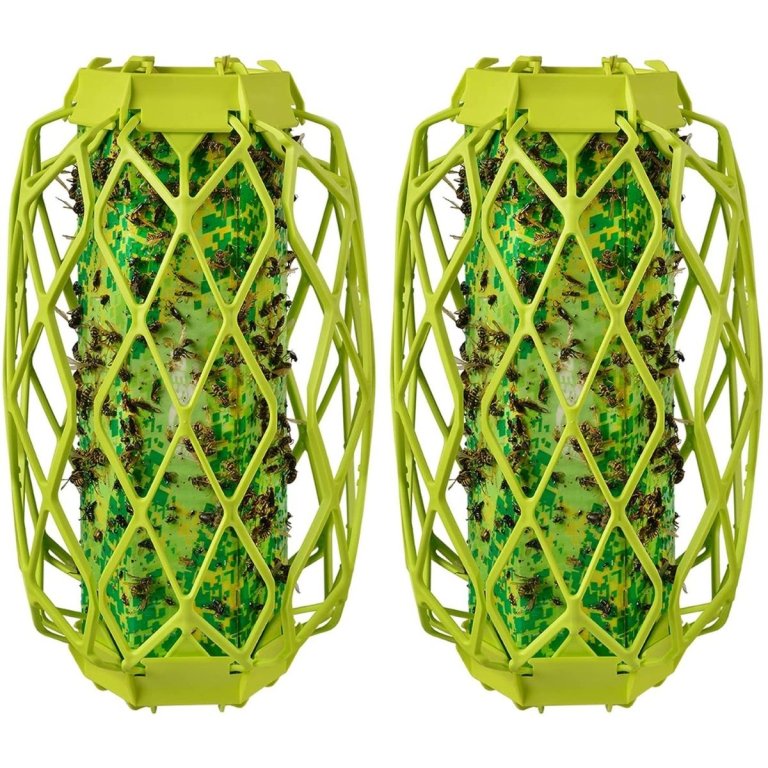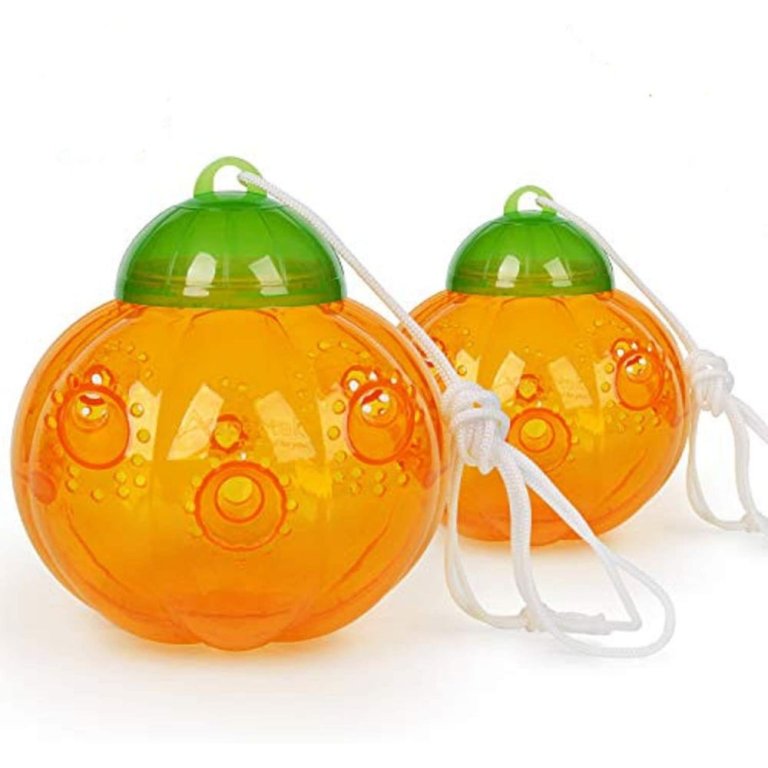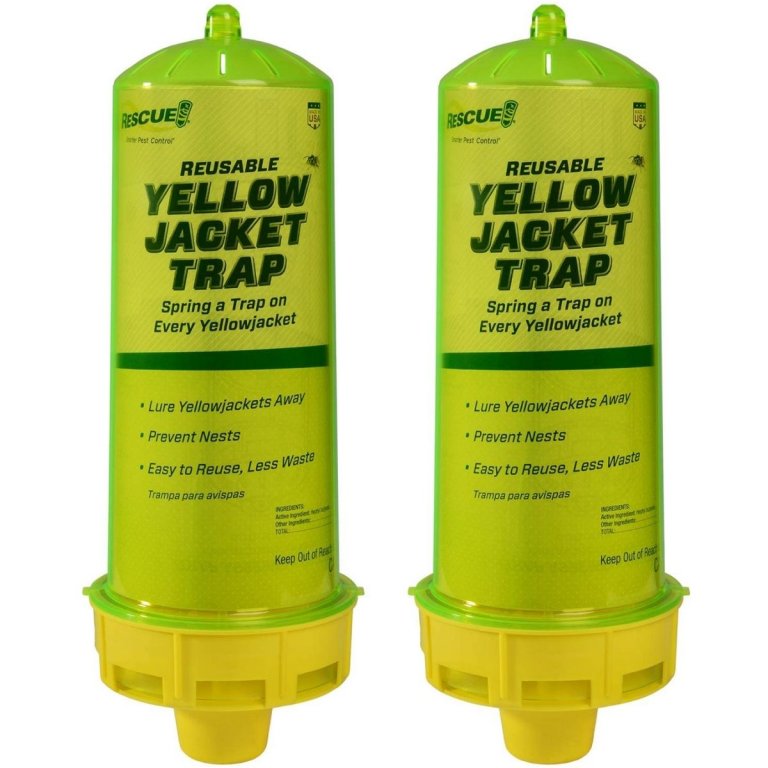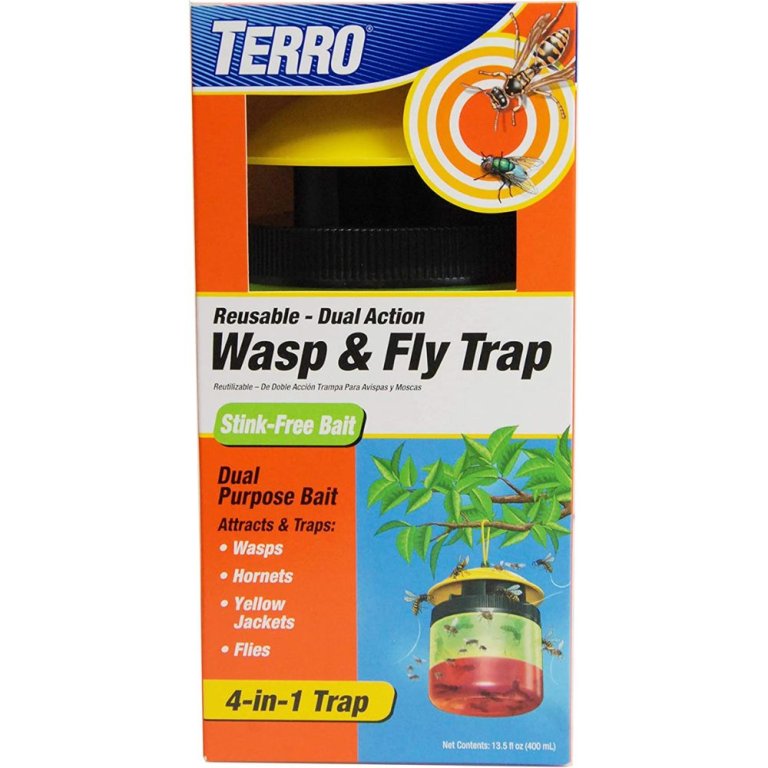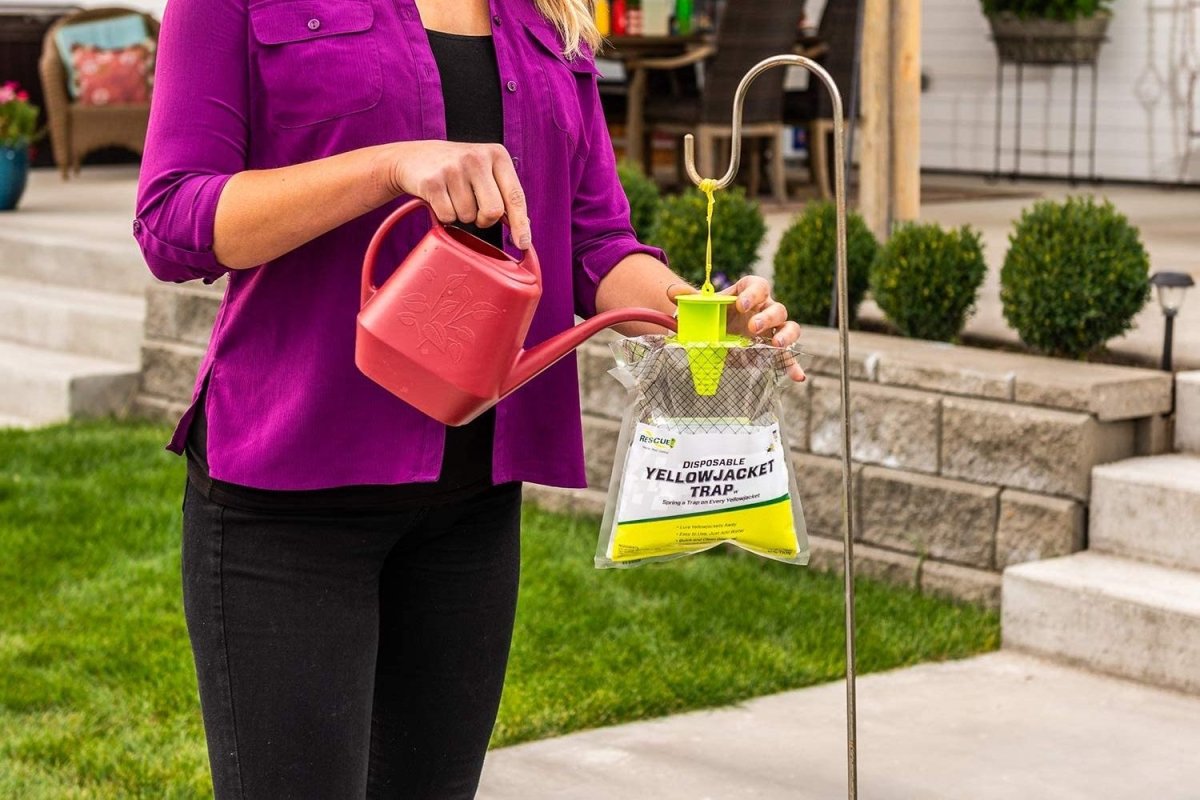
We may earn revenue from the products available on this page and participate in affiliate programs. Learn More ›
While wasps can be a helpful insect to have in the yard—eliminating grubs and other pests that can feast on your landscaping—they can also be a nuisance or hazard if allowed to build nests in and around dwellings. While taking out any wasp nests is one option, a better strategy might be to prevent those nests from forming in the first place by employing the services of a good wasp trap.
Wasp traps consist of bags or containers that contain bait that attracts wasps. A funnel-shaped opening on the container allows the wasps to crawl in but prevents them from leaving. Once trapped inside, the wasp either drowns or suffocates, depending on the type of trap. This guide will explore the world of wasp traps to identify which features are vital to consider when shopping for the best wasp trap.
- BEST OVERALL: Rescue! Disposable Summer Yellowjacket Trap
- BEST BANG FOR THE BUCK: Stingmon Hanging Wasp Trap
- BEST STICKY: Rescue! Wasp TrapStik
- BEST ATTRACTIVE: Aspectek Wasp Trap
- BEST REUSABLE: Rescue! Reusable Yellowjacket Trap
- ALSO CONSIDER: Terro Wasp & Fly Trap
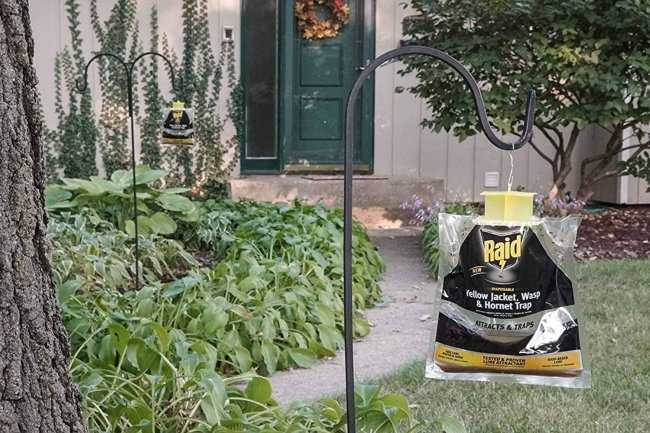
Before You Buy a Wasp Trap
Before buying a wasp trap, there are several factors to consider. Wasp traps can be beneficial in managing small to moderate wasp populations, particularly in contained areas such as small yards or patios. However, they might not be the most efficient solution for extensive infestations or large, open areas.
While wasp traps can effectively reduce the number of foraging wasps, they don’t necessarily solve the issue if there’s a nest nearby. It’s also important to remember that traps may inadvertently capture nontarget beneficial insects, like bees, depending on the bait used.
If you’re looking for an eco-friendly, more humane method, consider starting with a wasp repellent. Many repellents can deter wasps from setting up a nest in the first place, and they pose less risk to nontarget species.
How We Chose the Best Wasp Traps
In reviewing dozens of wasp traps for our list, we considered several important criteria, including ease of use, effectiveness, and even aesthetics. A wasp trap should not be difficult to set up or dispose of once full. With that in mind, we only chose traps that one could set up in a matter of minutes. For disposable traps, we chose models that you could easily remove and place in the trash.
All the reusable models we chose include traps that could be opened and emptied without having to directly come into contact with the victims. Wasp traps need to attract wasps, so we only selected traps that incorporated baits that were effective at luring wasps to the trap. Although aesthetics were not paramount, we know that many traps can detract from landscaping. With that in mind, we included some traps with an ornamental look that blends well with landscaping.
Our Top Picks
The list below narrows the field to some of the top wasp traps on the market. These traps are easy to set up and use baits and designs that make them effective; some models even blend in well with landscaping.
Best Overall
Rescue! Disposable Summer Yellowjacket Trap
Pros
- Easy to set up, requiring minimal assembly and installation
- Convenient disposal design—no messy cleanups required
- Uses nontoxic bait, making it safe for use around pets and children
Cons
- Effective for wasps in Central and Eastern time zones only
Product Specs
- Type: Disposable
- Quantity: 6 traps
- Material: Plastic bag
With its simple yet effective design, this trap from Rescue is one of the most effective ways to trap wasps. To use, simply add water to activate the powdered bait and then hang from a pole or a tree near wasp activity. Wasps, attracted to the bait, fly into the trap, which measures 8 inches long by 8 inches wide. Once inside, they become trapped and drown in the liquid. A convenient meter on the side helps you estimate how many victims the bag has caught.
Once the trap is full, simply drop it into an outdoor trash can. There’s no need to come into contact with any armed survivors. And, since this trap is also nontoxic, it’s safe for use in the yard around pets and children. Note that this particular trap uses a bait specially designed to catch wasps located in the Central and Eastern time zones of the U.S., so it isn’t a good choice for those living west of the Mississippi.
Get the Rescue! disposable wasp trap at Amazon, The Home Depot (for a single trap), or Walmart (for a single trap).
Best Bang for the Buck
Stingmon Hanging Wasp Trap
Pros
- Uses renewable energy by charging with solar power during the day
- The dual-entry tunnels trap wasps effectively
- High-quality materials ensure durability and weather resistance
Cons
- Requires additional purchase and preparation of bait
Product Specs
- Type: Reusable
- Quantity: 2 hanging traps
- Material: Polypropylene
These solar traps are an innovative and environmentally friendly solution for managing wasp populations. Harnessing the power of solar energy, the traps charge during the day and function at night. Their blue ultraviolet light automatically emits warm light in the dark, effectively attracting flying insects. Designed with dual-entry tunnels, which are larger on the outside than the inside, it ensures wasps cannot escape once they enter. Since these traps come in a pack of two, they offer excellent value.
This trap doesn’t come with a wasp attractant but its design allows you to add your choice of bait. The trap can then be hung in areas with high insect activity for effective wasp control.
Get the Stingmon wasp trap at Amazon.
Best Sticky
Rescue! Wasp TrapStik
Pros
- No need to add your own bait since this trap has a built-in attractant
- It’s easy to set up, install, and dispose of when it’s full
- The mesh guard deters birds, making this trap safer for the surrounding ecosystem
Cons
- The cost for this trap is high considering that it’s disposable
Product Specs
- Type: Sticky
- Quantity: 2 traps
- Material: Plastic cylinder
Taking a page out of a spider’s playbook, this set of two traps catches wasps by luring them to a sticky surface that ensnares them. Unlike other traps that use a sugary substance to lure in wasps, these traps attract them with its VisiLure technology, which uses colors that wasps like to rein them in. Once it lands on the trap, the wasp becomes hopelessly stuck where it eventually dies of dehydration.
The trap measures just over 11 inches long and 4.4 inches in diameter, providing enough surface area to catch hundreds of wasps; it hangs from a tree, limb, or hook by a short chain. A plastic guard that surrounds the entire trap is large enough to allow wasps in but not larger animals such as birds. Once the trap is full, simply throw it away and replace it.
Get the Rescue! TrapStik wasp trap at Amazon, Ace Hardware (for a single trap), Tractor Supply Co. (for a single trap), or Walmart.
Best Attractive
Aspectek Wasp Traps
Pros
- These traps have a more attractive look than most other traps on the market
- Since they come in a set of 2, they can be spaced out as needed
- Each trap has multiple entrances, making it easier for wasps to get inside
Cons
- Users must add their own wasp attractant to the trap for it to be effective
Product Specs
- Type: Reusable
- Quantity: 2 hanging traps
- Material: Plastic containers
The natural look and reusable design of this set of two wasp catchers from Aspectek makes them a worthy choice for outdoor living spaces. The traps have an attractive orange color and rounded shape. And, unlike similar traps that have a single-hole location, this trap has multiple holes, making it easier for wasps to enter the trap.
Each pot includes a nylon cord for hanging the trap from a tree branch or hook. When full, the lid unscrews, creating a wide opening for emptying the trap’s contents. And, at 5.1 inches long by 5.5 inches wide, it’s capable of holding a fair amount of wasps, extending the time between cleanings.
Get the Aspectek wasp trap at Amazon, The Home Depot, Aspectek, or Walmart.
Best Reusable
RESCUE! Reusable Yellowjacket Trap – 2 Pack
Pros
- The reusable design makes these traps more eco-friendly than disposable alternatives
- Since they come in a set of 2, they offer good value
- Easy to view inside to determine when the trap needs to be emptied
Cons
- The larger size of these traps makes them more conspicuous
Product Specs
- Type: Reusable
- Quantity: 2 traps
- Material: Plastic cylindrical containers
Those who don’t mind the unpleasantness and potential danger that comes with a reusable wasp trap might want to consider this option from Rescue! The traps consist of a plastic cylinder that measures about 10 inches long and 6 inches in diameter. Inside the cylinder is an inverted funnel that serves as an entrance, allowing wasps to enter but preventing them from exiting. The trap uses a special attractant made by Rescue! to lure in wasps. You can purchase refills of the attractant or use household baits. With its large size, the reusable trap can hold a large number of wasps before needing to be emptied.
Once it’s full, simply unscrew the trap’s bottom and empty the container into the trash. Since it is reusable and uses no baits, this trap is one of the more eco-friendly options on the market, and this option comes as a two-pack.
Get the Rescue! reusable wasp trap at Amazon (for the 2-pack), Ace Hardware, The Home Depot, Tractor Supply Co., or Walmart.
Also Consider
Terro Wasp & Fly Trap
Pros
- Attracts wasps and hornets as well as flies
- Lidded design makes for easy cleaning
- Comes with approximately 4 weeks of wasp bait
Cons
- Bait may need frequent replacement for optimal results
Product Specs
- Type: Reusable
- Quantity: 1 trap
- Material: Plastic container
The Terro wasp and fly trap is a practical and efficient tool for controlling wasp and fly populations. This reusable trap is designed for outdoor use and is equipped with a built-in lure that attracts pests. Its lidded design allows for easy filling and cleaning, making maintenance a breeze. The bait needs to be replaced every 4 weeks or when the trap is full. For the best results, the brand recommends placing this trap approximately 5 feet off the ground in a sunny area.
This trap is particularly noteworthy because of its versatility: It not only attracts and kills wasps and hornets, but it’s also effective against flies.
Get the Terro wasp trap at Amazon, Ace Hardware, Lowe’s, or The Home Depot.
Our Verdict
When it comes to wasp control, products like Raid Wasp & Hornet Killer, Black Flag Wasp & Hornet Killer, and Ortho Home Defense are popular for their efficacy. However, these wasp-killing sprays and foams fall short of our sustainability guidelines. Despite their popularity, we don’t recommend them in our top picks due to concerns about their environmental impact, harmful chemical ingredients, and potential health hazards to nontarget species and humans.
Or, DIY Your Own Wasp Trap
While there are plenty of great commercially available wasp traps, creating your own DIY version is a cost-effective and eco-friendly alternative to buying one. Using simple materials found around the house, you can quickly assemble a trap that effectively captures wasps.
First, gather the necessary materials:
- Plastic bottle
- Sharp knife or scissors
- A piece of wire or string
- Sweet liquid bait such as sugar water or fruit juice
Start by cutting the plastic bottle about one-third of the way down from the top. Remove the cap and invert the top portion of the bottle, placing it inside the lower portion to create a funnel-like entrance. Secure the two sections together using the wire or string.
Next, poke a few small holes near the top of the bottle to allow the scent of the bait to escape and attract the wasps. Fill the bottom of the trap with the bait, ensuring it reaches just below the funnel entrance.
Try hanging your homemade wasp trap in a location where wasps tend to gather, but make sure to position it away from where people gather to avoid attracting the wasps towards human activity.
Jump to Our Top Picks
What to Consider When Choosing the Best Wasp Traps
Read on to learn about the different types of wasp traps and crucial factors to consider when shopping for a wasp trap, such as safety, weather resistance, and eco-friendliness.
Types of Wasp Traps
Wasp traps come in reusable, disposable, and sticky varieties. Reusable traps are tubular with a funnel-shaped entrance that, like the Hotel California, allows wasps to enter, but they can never leave. A lure inside the tube attracts the wasps inside. Once trapped, they eventually die from dehydration. The bottom of these traps comes off so the trap can be cleaned out once it’s full.
Disposable traps function similarly to reusable traps. They use a lure to attract the wasps through a funnel-shaped opening that allows them to enter but prevents them from exiting. Instead of a rigid plastic cylinder, disposable traps use a plastic bag. Once they are full, simply throw the whole trap away. And while there is no risk of coming into contact with vengeful survivors with a disposable trap, they are not eco-friendly, nor are they economical, as you must continually replace them.
Sticky traps consist of a cone-shaped cylinder covered in sticky glue. When the wasp lands on the sticky substance, it becomes hopelessly stuck and eventually dies of dehydration. While sticky traps are an effective way of catching wasps, they’ll also catch and kill other types of insects, including beneficial ones. And, unless the trap has a guard around it, it can even cause problems for birds attracted to the insects stuck to it.
Safety and Eco-Friendliness
Wasp traps do not use harmful chemicals. They use food-based baits to attract the wasps then allow nature to take its course once the wasps are trapped or stuck by drowning them or depriving them of water and food until they die. Reusable traps are the most eco-conscious, since they employ a reusable container as opposed to disposable plastic bags. Sticky traps are perhaps the least eco-friendly option. Not only do they use a disposable design, but they are also most prone to harming beneficial insects and even smaller birds and mammals.
Bait Type
Most wasp trap bait typically consists of a sugary powder inside the container that you activate by adding water just before setting up the trap. Reusable traps use either wasp baits, which you can purchase separately, or foods commonly found in the kitchen pantry, such as apple cider vinegar, soft drinks, or even jam and jelly. Sticky traps attract wasps by using colors that appeal to them, such as bright orange and yellow.
Weather Resistance and Reusability
Since wasp traps spend weeks outside collecting their victims, they’re designed to endure wet weather. They are made out of water-resistant plastic with entrance holes that are small enough and strategically placed so the trap is not affected by rainfall. Since wasp activity mainly occurs during warmer months, there’s no need for wasp traps to endure winter weather.
In addition to having a weather-resistant design, reusable traps typically have ends that you can unscrew to easily dump the contents of the trap. Once empty, the trap is ready to go back into service.
Ease of Setup
Most wasp traps can be set up in minutes. Simply hang the trap close to wasp activity. Open the trap door and add bait or water as directed. Once the trap is full, remove it and throw it away if it’s a disposable trap, or clean out the contents and add fresh bait if it’s a reusable trap.
Tips for Using Wasp Traps
While many people set up traps in the summertime once wasps become a threat, by then it is often too late. Wasps have already established nests and have begun reproducing. A wasp trap is no match for a thriving wasp nest. At that point, it’s best to use a spray. By midsummer, there’s also an abundance of food for these pests to feed on, making them less likely to enter a trap. Nip the problem in the bud and set up a wasp trap in spring when they haven’t had a chance to establish a nest and begin reproducing.
Trap placement is also key. Since traps work by luring wasps in, don’t put them too close to living areas. Place wasp traps at least 20 feet away from outdoor living spaces. Be strategic about where you hang a wasp trap. Hang the trap in a branch of a fruit tree, which is where wasps often gather to feast on fruit.
- Hang traps in the spring to control the wasp population.
- Don’t place wasp traps close to outdoor living spaces.
- Hang traps where wasps gather, such as near fruit trees.
FAQs
If you’re wondering where to hang your new wasp trap or how to clean it, then read on for answers to these and other important questions about these devices.
Q. How effective are wasp traps?
Wasp traps are effective at attracting and trapping wasps; however, it’s crucial that you place them properly. Wasp traps that are placed too close to living areas will actually attract more wasps to the area, increasing the likelihood of stings.
Q. Where should I hang a wasp trap?
Hang wasp traps at least 20 feet away from living spaces to ensure wasp activity does not increase near people. If possible, hang them in the boughs of nearby fruit trees, where wasps search for food.
Q. What should I put in a wasp trap?
When making a wasp trap, it’s important to use bait that effectively lures wasps but doesn’t attract beneficial insects. Wasps are drawn to a variety of foods, but they particularly favor high-sugar substances. That makes sugary soft drinks, fruit juices, and sugar water the best baits for a wasp trap.
Q. How do I clean a reusable wasp trap?
First, make sure that there are no live wasps inside the trap to prevent potential stings. Next, remove the trap and carry it to an outdoor trash can. Remove the trap’s lid, then dump the dead wasps into the trash can. Use a hose to rinse out the trap, then reapply bait.
Q. Do bees get caught in wasp traps?
Depending on the type of bait you use, beescan end up caught in the trap. Bees and wasps share similar dietary habits, and are both attracted to sweet substances.
However, there are methods to minimize the risk of trapping bees. One strategy is to use a specific type of bait, such as heptyl butyrate, a chemical that wasps find enticing but bees tend to ignore.

